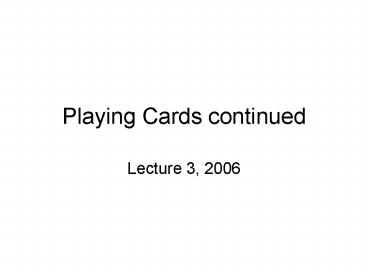Playing Cards continued - PowerPoint PPT Presentation
1 / 15
Title:
Playing Cards continued
Description:
colour Spades = Black. colour Hearts = Red. colour Diamonds = Red. colour Clubs = Black ... Spades. Card{rank=Numeric 8,suit=Diamonds} ... – PowerPoint PPT presentation
Number of Views:72
Avg rating:3.0/5.0
Title: Playing Cards continued
1
Playing Cards continued
- Lecture 3, 2006
2
Recall
- Were modelling card play in Haskell
- Defined
- New types Suit and Colour
- colour Suit -gt Colour
colour Suit -gt Colour colour Spades
Black colour Hearts Red colour Diamonds
Red colour Clubs Black
3
Modelling a Card
- A Card has both a Rank and a Suit
- Define functions to inspect both
data Card Card Rank Suit deriving Show
rank Card -gt Rank rank (Card r s) r suit
Card -gt Suit suit (Card r s) s
4
A Useful Abbreviation
- Define type and inspection functions together, as
follows
data Card Card rank Rank, suit Suit
deriving Show
5
Modelling a Hand of Cards
- A hand may contain any number of cards from zero
up! - The solution is recursion!
We cant use !!!
data Hand Cards Card Card deriving Show
6
Modelling a Hand of Cards
- A hand may contain any number of cards from zero
up! - A hand may be empty
- It may consist of a first card and the rest
- The rest is another hand of cards!
data Hand Empty Add Card Hand deriving
Show
Solve the problem of modelling a hand with one
fewer cards!
A recursive type!
7
When can a hand beat a card?
- An empty hand beats nothing
- A non-empty hand can beat a card if the first
card can, or the rest of the hand can! - A recursive function!
handBeats Suit -gt Hand -gt Card -gt
Bool handBeats trump Empty c' False handBeats
trump (Add c h) c' cardBeats trump c c'
handBeats trump h c'
8
Choose a card to play
- Given
- Trump suit
- Card to beat
- The hand
- Beat the card if possible!
9
Strategy
- If the hand is only one card, play it
- If there is a choice,
- Select the best card from the rest of the hand
- Choose between it and the first card
- Principles
- Follow suit if possible
- Play lowest winning card if possible
- Play lowest losing card otherwise
10
The Code
-- chooseCard trump beat hand chooses a card from
hand to -- play, when trump is the trump suit and
beat is the card to -- be beaten chooseCard
Suit -gt Card -gt Hand -gt Hand chooseCard trump
beat (Add c Empty) c chooseCard trump beat (Add
c rest) suit csuit beat suit c/suit
beat c suit c/suit beat suit csuit
beat c cardBeats trump c beat not
(cardBeats trump c beat) c cardBeats
trump c beat not (cardBeats trump c beat)
c rankBeats (rank c) (rank c) c
otherwise c where c chooseCard trump
beat rest
11
Properties of chooseCard
- Complicated code with great potential for errors!
- Possible properties
- chooseCard returns a card from the hand (no
cards up the sleeve) - chooseCard follows suit if possible (no
cheating) - chooseCard always wins if possible
12
Testing chooseCard
prop_chooseCardWinsIfPossible trump c h
h/Empty gt handBeats trump h c
cardBeats trump (chooseCard trump c h) c
Maingt quickCheck prop_chooseCardWinsIfPossible Fal
sifiable, after 3 tests Spades CardrankNumeric
8,suitDiamonds Add CardrankNumeric
4,suitDiamonds (Add CardrankNumeric
10,suitSpades Empty)
What went wrong?
13
What Did We Learn?
- Modelling the problem using datatypes with
components - Using recursive datatypes to model things of
varying size - Using recursive functions to manipulate recursive
datatypes - Writing properties of more complex algorithms
14
Reminder Modelling a Hand
- A Hand is either
- An empty hand
- Formed by adding a card to a smaller hand
- Discarding the first card
data Hand Empty Add Card Hand deriving
Show
discard (Add c h) h
15
Reading
- Datatypes are covered in Chapter 14 of the book.































